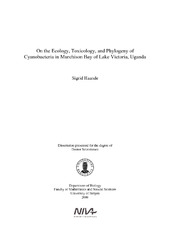On the ecology, toxicology, and phylogeny of cyanobacteria in Murchison Bay of Lake Victoria, Uganda
Abstract
One of the major threats to Lake Victoria is eutrophication and an increasing proliferation of cyanobacteria. Many cyanobacterial species have the ability to produce toxic compounds (cyanotoxins), which can cause considerable hazards for animal and human health. Thus, blooms of toxin-producing cyanobacteria receive increased attention when developing in drinking water supplies and inland waters used for recreational activities. Murchison Bay is a 30 km long embayment in the north western part of Lake Victoria, and is divided in a semienclosed inner part and a wider outer part by narrows about 5 km out in the bay. The capital city of Uganda, Kampala, is situated close to Murchison Bay, which serves as the drinking water supply for the population of the city and the surrounding areas. The bay is influenced by local pressures like urban pollution, erosion, flooding, and wetland degradation and is the recipient of both industrial and municipal wastes, sewage effluents and surface runoff from the city. The aims of this study have been to promote the knowledge on the eutrophication and proliferation of cyanobacteria in Lake Victoria, to assess the possible cyanotoxin (microcystin) production and to describe the morphological, genetic and chemical diversity of cyanobacteria from Lake Victoria and other East-African water bodies. The sampling of Murchison Bay was carried out from November 2000 to March 2004. The study showed that there was a heavy loading of nutrients to Murchison Bay and there were high concentrations of total phosphorous (>90μg/L) and total nitrogen (>1100μg/L) in the inner part of the bay. There was a rapid decrease in conductivity and nutrient concentrations from the innermost part of the bay to the outer part of the bay. We found that surface seiches caused considerable water exchange with the main lake and thereby mediated the eutrophication in the Inner Murchison Bay. The bay is a more dynamic system than first recognized and the rapid transport of nutrients to the open lake indicates that Murchison Bay contributes to the eutrophication process of Lake Victoria. The phytoplankton community was dominated by a variety of cyanobacterial species and diatoms. The proportion of N-fixing species like Anabaena sp. was higher in the outer part of the bay whereas Microcystis sp. was more abundant in the inner part of the bay. There were microcystins (MC-RR, -LR, -YR) present in Murchison Bay, on average 1.1 μg L-1 in the inner part of the bay and 0.6 μg L-1 in the outer part of the bay. Based on probability analysis, Microcystis aeruginosa was identified as the main microcystin producer. Several cyanobacterial strains of M. aeruginosa and Cylindrospermopsis raciborskii were isolated from Murchison Bay and other lakes in the East African region and these strains were morphologically, genetically and chemically characterized. Phylogenetic analyses showed that the East-African strains of M. aeruginosa were closely related to other strains of M. aeruginosa of different geographical regions, whereas the phylogenetic analyses comparing C. raciborskii strains from Uganda and Germany to strains from other continents, revealed that strains from the same continent were more closely related to each other than the strains originating from different continents. Some of the strains of M. aeruginosa were microcystin producing, and none of the C. raciborskii strains were producing cylindrospermopsin. Two water works are situated at the shores of the Inner Murchison Bay. Water from different steps in the purification process were analysed, and microcystins were not detected. There is, however, a risk for exposure to microcystins for those using the lake water directly as drinking water and increased awareness of cyanobacterial blooms in Murchison Bay is needed.
Has parts
Paper I: Larsson, P.; Haande, S.; Luyiga, S.; Semyalo, R.; Kizito, Y. S.; Miyingo-Kezimbira, A.; Brettum, P.; Lyche-Solheim, A.; Odong, R.; Asio, S. A.; Jensen, K. H., (2008), Surface seiches mediate pollution in a eutrophic bay of Lake Victoria. Draft. (Submitted). Full text not available in BORA.Paper II: Haande, S.; Rohrlack, T.; Brettum, P.; Edvardsen, B.; Lyche-Solheim, A.; Larsson, P., Pytoplankton dynamics and cyanobacterial dominance in Murchison Bay of Lake Victoria (Uganda) in relation to environmental conditions. Draft. (In manuscript). Full text not available in BORA.
Paper III: Haande, S.; Rohrlack, T.; Brettum, P.; Ptacnik, R.; Edvardsen, B.; Lyche-Solheim, A.; Larsson, P., On the occurrence of microcystin producing cyanobacteria in Murchison Bay of Lake Victoria (Uganda). Draft. (Submitted). Full text not available in BORA.
Paper IV: Archives of Microbiology 188(1), Haande, S.; Ballot, A.; Rohrlack T, Fastner J, Wiedner C, Edvardsen B (2007) Diversity of Microcystis aeruginosa isolates (Chroococcales, Cyanobacteria) from East-African water bodies, pp. 1-15. Copyright 2007 Springer. Full text not available in BORA due to publisher restrictions. The published version is available at: http://dx.doi.org/10.1007/s00203-007-0219-8
Paper V: Harmful Algae 7(5), Haande, S.; Rohrlack, T.; Ballot, A.; Røberg, K.; Skulberg, R.; Beck, M.; Wiedner, C., Genetic characterisation of Cylindrospermopsis raciborskii isolates (Nostocales, Cyanobacteria) from Africa and Europe, pp. 692-701. Copyright 2008 Elsevier B.V. Full text not available in BORA due to publisher restrictions. The published version is available at: http://dx.doi.org/10.1016/j.hal.2008.02.010
